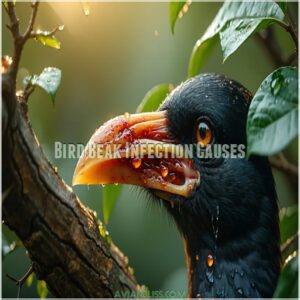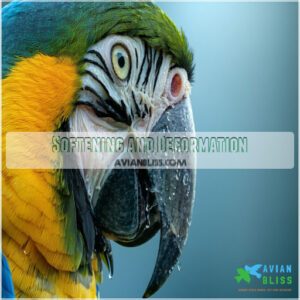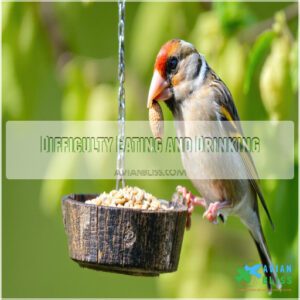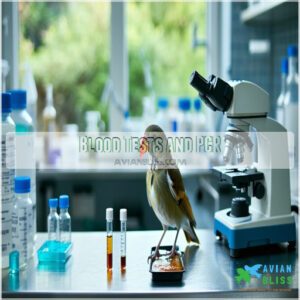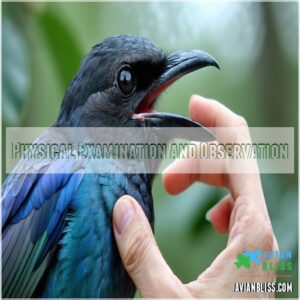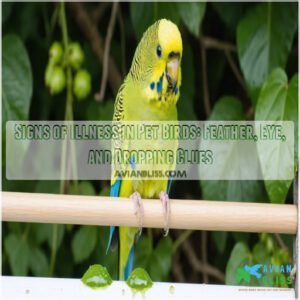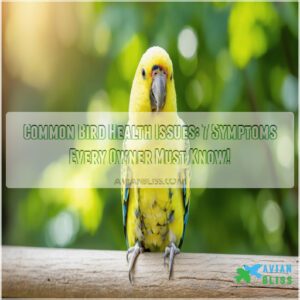This site is supported by our readers. We may earn a commission, at no cost to you, if you purchase through links.
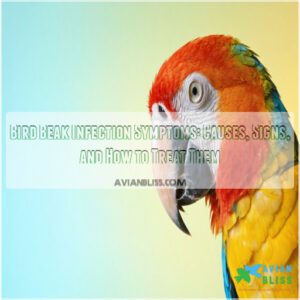 Spotting bird beak infection symptoms early can make all the difference for your feathered friend.
Spotting bird beak infection symptoms early can make all the difference for your feathered friend.
Look for cracks, discoloration, or softening of the beak—it shouldn’t feel like a sponge! If eating’s a struggle or the beak grows unevenly, these are big red flags.
Swelling, flaky skin, or odd shapes are also signs of trouble. Infections might cause feather loss or even breathing problems if things get serious.
Whether it’s bacterial, fungal, viral, or from pesky mites, getting your bird checked pronto is key. A clean cage, good diet, and quick treatment can save the day and keep your bird chirping happily!
Table Of Contents
- Key Takeaways
- Bird Beak Infection Causes
- Beak Infection Symptoms
- Beak Problem Risk Factors
- Diagnosing Beak Infections
- Treating Beak Infections
- Frequently Asked Questions (FAQs)
- How do health problems affect a bird’s beak?
- Are beak problems common in pet birds?
- What are common beak problems?
- How do you know if a bird has a beak problem?
- How to prevent beak problems in birds?
- How do you know if a bird has a problem?
- What does beak disease look like?
- How do you know if your bird has a bacterial infection?
- What does an unhealthy bird’s beak look like?
- What is the life expectancy of a bird with PBFD?
- Conclusion
Key Takeaways
- Look for cracks, discoloration, softening, or uneven growth on your bird’s beak—these are early infection signs you shouldn’t ignore.
- Difficulty eating, swelling, or flaky skin around the beak can signal serious issues like bacterial, fungal, or parasitic infections.
- A clean cage, balanced diet, and regular vet checkups are key to preventing and treating bird beak problems effectively.
- Catch symptoms like respiratory issues or feather loss early, as they might indicate severe conditions like Psittacine beak and feather disease (PBFD).
Bird Beak Infection Causes
Infections in a bird’s beak can happen for several reasons, like bacteria, fungi, viruses, or parasites sneaking in.
These culprits often find their way in through injuries, poor hygiene, or a weakened immune system.
Bacterial Infections
Bacterial infections can wreak havoc on your bird’s beak, often causing painful lesions or swelling.
They’re usually triggered by poor hygiene or minor injuries that let harmful bacteria take over.
- Watch for red, swollen spots or cracks on the beak.
- Keep environments clean to prevent bacterial strains from thriving.
- Infection control often involves antibiotic use prescribed by your vet.
Fungal Infections
Fungal infections, like beak fungal disease, can stem from tiny fungal spores in dirty cages or poor diets.
Candida, a common culprit, often causes soft, discolored patches on the beak.
These beak fungus symptoms aren’t just cosmetic; they make eating tough.
Yeast control and antifungal medications are key fungal treatments.
Regular cleaning and a balanced diet help prevent avian mycosis altogether.
Viral Infections
Viruses can pack a punch regarding bird beak infection symptoms.
Psittacine beak and feather disease (BFDV) is a big offender, causing beak lesions, feather loss, and even respiratory issues.
This nasty bug spreads through direct contact or contaminated surfaces.
If you notice unusual changes, like a brittle beak, act fast—avian diseases like these don’t fix themselves, as they can lead to severe issues like respiratory issues.
Parasitic Infections
Parasites love to hitch a ride, and your bird’s beak is fair game.
Parasitic infections, like scaly face mites, can cause serious beak infection symptoms. Watch for flaky skin or irritated beaks.
Stay proactive with these steps:
- Parasite Control: Regular checkups.
- Mite Infestations: Clean cages often.
- Tick Prevention: Use safe repellents.
- Lice Removal: Specialized sprays work wonders.
Understanding parasite prevention methods is key to protecting your birds from infection.
Beak Infection Symptoms
When your bird’s beak looks discolored, cracked, or misshapen, it could be a sign of an infection.
Keep an eye out for changes like softening, unusual growth, or trouble eating, as these symptoms shouldn’t be ignored.
Discoloration and Cracks
When you notice beak discoloration or cracks, don’t brush it off—it’s often a sign of beak health problems like infections or poor nutrition.
Trauma, beak fissures, or even fungal spots can lead to pain or worsen into beak bleeding and secondary infections.
Spotting these beak infection symptoms early can save your bird stress and protect its health.
Regular checks for beak health issues can help identify problems before they become severe.
Softening and Deformation
If your bird’s beak feels soft or looks oddly shaped, it’s a red flag.
Beak softening can stem from keratin issues, infections like a parrot beak bacterial infection, or even past trauma.
This deformation causes trouble eating and grooming, so don’t wait.
Keep an eye out for these beak infection symptoms and consult a vet to address possible issues early.
Abnormal Growth and Shape
Sometimes, a beak deformity sneaks up, changing the normal growth patterns.
You might see an abnormal beak shape, with beak overgrowth or asymmetrical shapes like scissor beak.
Beak scarring or abnormal curvature can also show up, making the beak look off.
These misaligned beak issues aren’t just cosmetic—they can mess with your bird’s comfort and daily habits.
Difficulty Eating and Drinking
Trouble eating? A bird beak infection can mess with food intake and water access.
Beak pain symptoms, lesions, or misalignment make swallowing tricky, leading to poor eating habits. Fungal plaques or scaly deposits often cause these swallowing issues.
If left untreated, difficulty eating can weaken your bird, so watch for avian beak problems and seek help fast!
Identifying beak health issues is essential for preventing further complications and ensuring your bird’s overall health and wellness, which can be affected by beak and feather disease.
Beak Problem Risk Factors
Your bird’s beak health isn’t just about looks—it’s tied to their diet, activity, and overall care.
Poor nutrition, cramped spaces, or even genetics can all increase the risk of problems.
Poor Diet and Nutrition
Poor food quality and malnutrition hit harder than you’d think.
Nutritional deficiencies, like low vitamin A, weaken the beak’s keratin, inviting cracks, infections, and discoloration.
A dietary imbalance—too little calcium or phosphorus—leads to brittle or soft beaks.
If your bird’s diet lacks hard foods, overgrown beaks become a hotspot for fungus and parasites.
Consider vitamin supplements for support.
Insufficient Exercise and Space
A cramped cage can mess with your bird’s mood and health.
Cage Size Matters because tight spaces limit Bird Activity and Exercise Needs, leading to stress and weakened immunity.
Toss in some Avian Enrichment like toys and perches to prevent boredom.
Without enough room, parrot beak infection risks climb, including beak abscess symptoms and painful bird beak lesions.
Underlying Health Conditions
Birds dealing with big health issues often show problems in their beaks.
Things like respiratory issues, liver disease, kidney problems, or a weak immune system can lead to infections.
Watch for:
- Beak abscess symptoms or fungal infections like Candida
- Trouble with heart conditions affecting beak color
- Weakness from chronic illnesses
- Poor healing from minor injuries
- Delayed response to beak infection treatment
The list of symptoms to watch for is crucial for identifying potential beak problems.
Genetic Predisposition
Sometimes, it’s in their DNA.
Certain birds inherit beak deformities or traits that make them prone to infections, like Psittacine beak and feather disease.
Genetic testing through DNA research can spot these risks early.
Breeding practices matter too—avoiding inherited disorders is key.
If your bird’s showing issues, a proper beak disease diagnosis can guide the right beak infection treatment.
Understanding the psittacine beak disease is essential for effective management and prevention of the infection.
Diagnosing Beak Infections
When your bird shows signs of a beak infection, getting a proper diagnosis is the first step to helping them heal.
A vet can run tests like bloodwork or take a close look at the beak to figure out what’s going on.
Veterinary Examination and Tests
Seeing a skilled avian vet is key for beak disease diagnosis.
They’ll run diagnostic tests like X-ray imaging to spot injuries or fractures.
Radiology tests or an endoscopy exam might uncover hidden issues.
Swab analysis helps find infections, while biopsy results reveal tissue health.
This hands-on veterinary care guarantees your bird gets the best help for its beak injury symptoms, ensuring the best possible outcome with a skilled veterinary care.
Blood Tests and PCR
You’ll undergo blood work, including DNA tests, to identify the infection.
PCR results help diagnose diseases, and lab testing and diagnostic tools analyze blood vessels, providing valuable insights.
Next-generation sequencing aids in DNA analysis, guiding treatment for your bird’s beak infection.
Understanding psittacine beak disease is essential for effective diagnosis and treatment of beak infections in birds.
Cytology and Culture
When you’re dealing with stubborn bird beak infection symptoms, cytology and culture can save the day.
A vet might swab the beak, gather tissue samples, or examine cells under a microscope.
This detailed lab testing helps pinpoint infections like bacteria or fungi, guiding the right treatment with microbial tests, ensuring better beak health.
It’s diagnostic testing that truly matters!
Physical Examination and Observation
When inspecting your bird’s beak, watch for obvious visual signs and behavioral changes.
A proper physical examination can uncover hidden beak symptoms that might affect avian health.
- Check texture and color: Look for cracks, discoloration, or swelling.
- Observe eating habits: Slow or messy eating signals a problem.
- Feel for abnormalities: Gently touch the beak for softening or deformation.
Treating Beak Infections
Treating beak infections takes patience, care, and quick action to help your bird heal.
You’ll need to focus on proper medications, improving hygiene, and possibly making diet changes to support recovery.
Medications and Antibiotics
Your vet might recommend antibiotics like doxycycline, azithromycin, or tetracycline to treat bacterial beak infections.
Fungal issues? Medications like itraconazole handle those.
For wounds, topical ointments or oral gels can work wonders.
Beak creams soothe cracks, but watch for antibiotic resistance by following prescriptions exactly.
Meds don’t cure viruses, but they help with secondary infections to keep your bird healthier longer.
Understanding doxycycline for birds treatment options is essential for effective care.
Dietary Changes and Supplements
Sometimes, medications aren’t enough.
Nutrition plays a huge role in helping with bird beak infection symptoms. A nutrient boost can speed up healing and prevent future trouble.
Try:
- Probiotics for gut health.
- Vitamin D and calcium to strengthen the beak.
- Mineral-rich foods like leafy greens.
- Organic foods, free from harmful chemicals.
- Vitamin supplements to fight nutritional deficiencies.
Considering natural bird food supplements can provide essential nutrient rich options to support overall health.
Environmental Adjustments and Hygiene
A clean cage isn’t just nice—it’s non-negotiable for healthy beaks.
Stay on top of cage hygiene by swapping nesting materials often and using safe cleaners.
Consider using effective bird cage cleaning products for maintaining hygiene.
Keep air quality fresh and humidity balanced; both reduce stress and infections.
Use water purification for drinking bowls and maintain sanitary conditions daily.
Small environmental changes make big differences in bird beak health.
| Tip | Why It Matters | Quick Action |
|---|---|---|
| Cage Cleaning | Reduces bacteria buildup | Change bedding weekly, sanitize. |
| Air Quality | Prevents irritants and stress | Use a purifier, ventilate room. |
| Water Purification | Guarantees safe drinking water | Change water daily, use filtered. |
| Humidity Control | Prevents dryness and cracking | Use a small humidifier, monitor. |
Small environmental changes make big differences in bird beak health.
Surgical Repair and Beak Trims
If cleaning and better hygiene don’t fix things, surgical tools step in.
Beak reconstruction fixes severe injuries, while beak prosthetics replace damaged parts.
For scissor beak or overgrowth, trim techniques help restore function.
Surgical repair may include avian orthodontics to reshape deformities.
It’s delicate work, so leave it to experts who know their way around tiny bird beaks.
Experts often utilize specialized beak repair tools to achieve desirable results, using surgical tools to ensure the best outcome.
Frequently Asked Questions (FAQs)
How do health problems affect a bird’s beak?
When your bird’s beak looks a little “off its game,” health issues might be the culprit.
Infections, injuries, or poor nutrition can lead to cracks, discoloration, or overgrowth, making eating and grooming a challenge.
Are beak problems common in pet birds?
Beak problems aren’t super common, but they do happen.
You might spot cracks, overgrowth, discoloration, or uneven shapes.
Keeping your bird’s diet balanced and cage safe can help prevent most beak troubles.
What are common beak problems?
Imagine spotting chips, cracks, or discoloration on your bird’s beak—like finding a scratch on a new car.
Common issues include overgrowth, injuries, infections, or even scaly mites.
Always check for changes early!
How do you know if a bird has a beak problem?
You’ll notice beak problems if your bird stops eating, struggles to chew, or their beak looks broken, discolored, or overgrown.
Watch for swelling, cracking, or unusual growths—these are big red flags to act fast.
How to prevent beak problems in birds?
A healthy beak starts with clean living.
Keep your bird’s cage spotless, provide chewable toys for beak exercise, and feed a balanced diet.
Regularly check their beak for cracks or discoloration—prevention beats recovery every time!
How do you know if a bird has a problem?
You’ll know something’s up if your bird acts off—less energy, stops eating, has weird growths, or their feathers look messy.
Check for changes in behavior, appetite, or appearance; those are big red flags.
What does beak disease look like?
When a bird’s beak has issues, it might look oddly shaped, cracked, overgrown, or discolored.
Watch for swelling, crusty patches, or flaking.
If chewing or grooming seems tough, something’s probably up with their beak.
How do you know if your bird has a bacterial infection?
If your bird’s acting off—losing appetite, looking droopy, or showing swelling, redness, or discharge around the beak—it might’ve a bacterial infection.
Pay attention to changes and get a vet involved quickly!
What does an unhealthy bird’s beak look like?
Ever heard that a bird’s beak reflects its health?
Watch for cracks, discoloration, uneven growth, swelling, or peeling.
If it looks dull or brittle, it’s time to dig deeper—your feathered friend might need help!
What is the life expectancy of a bird with PBFD?
Life expectancy with PBFD varies, but many birds live just months to a few years after symptoms show.
It depends on their immune system and care, but sadly, it’s a progressive and often fatal disease.
Conclusion
Catching bird beak infection symptoms early can feel like saving the day for your feathered buddy.
Keep an eye out for cracks, soft spots, or unusual growth—it’s your bird’s way of waving a red flag.
A clean home, good food, and a trip to the vet work wonders to tackle bacterial, fungal, or even parasitic culprits.
Don’t wait! Spotting trouble early keeps your bird chirping, thriving, and flashing that perfect beak in no time.
- https://www.petmd.com/bird/conditions/skin/c_bd_Psittacine_beak_and_feather_disease
- https://www.wires.org.au/wildlife-information/beak-and-feather-disease
- https://vcahospitals.com/know-your-pet/psittacine-beak-and-feather-disease-in-pet-birds
- https://www.petmojo.com/beak-problems-in-pet-birds/
- https://pangovet.com/pet-health-wellness/birds/common-beak-problems-in-birds/

